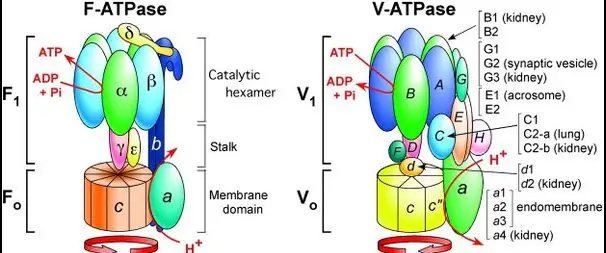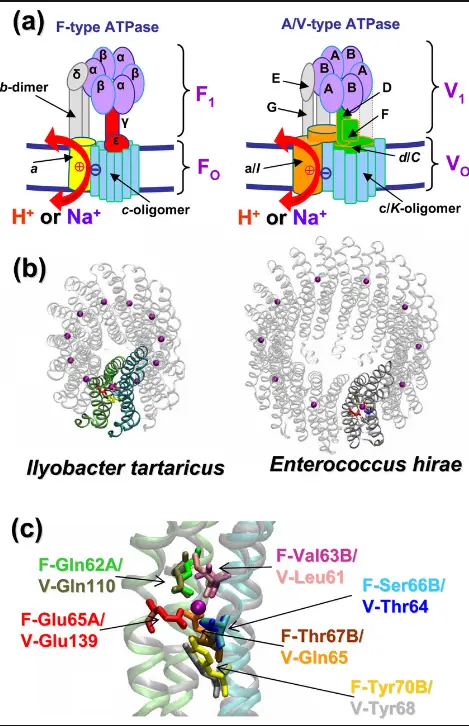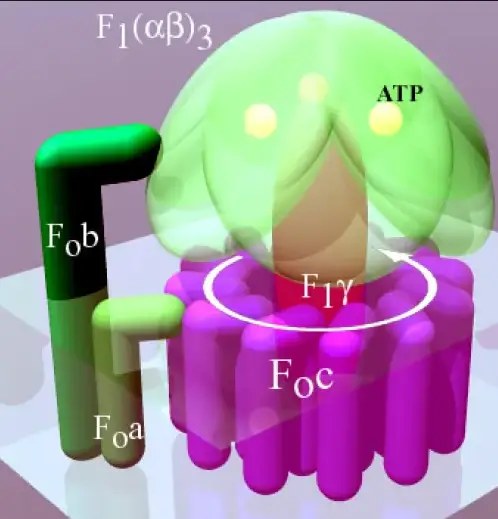ATPases are pivotal enzymes that play a crucial role in the energy dynamics of cellular processes across various organisms. These enzymes facilitate the conversion of adenosine triphosphate (ATP), the primary energy currency of the cell, into mechanical energy. This process is essential for numerous cellular activities, including transport, synthesis, and communication within cells.
The V Type and F Type ATPases, although similar in their fundamental purpose of ATP hydrolysis, exhibit distinct structural and functional characteristics. V Type ATPases primarily function in acidifying compartments like lysosomes and endosomes, crucial for intracellular digestion and processing. On the other hand, F Type ATPases mainly operate in synthesizing ATP, harnessing the potential energy of a proton gradient to power ATP synthesis.
These ATPases are not just biochemical curiosities but are integral to maintaining cellular viability and function. The V Type’s role in acidifying various organelles and the F Type’s involvement in ATP synthesis underpin many life-sustaining processes. Their importance extends from single-celled organisms to the complex tissues of humans, highlighting their evolutionary significance.

ATPase Basics
Definition and Role
ATPases are a class of enzymes critical to cell biology. They break down adenosine triphosphate (ATP), releasing energy that the cell uses for activities such as muscle contraction, nerve impulse propagation, and chemical synthesis. These enzymes are indispensable because they supply the energy necessary for virtually all physiological processes.
Common Features
ATPases share several key features:
- Binding Sites: They have specific sites for ATP binding and hydrolysis.
- Protein Structure: Typically composed of multiple subunits that assemble into complex structures.
- Energy Conversion: They convert chemical energy from ATP into various forms of mechanical energy.
- Regulation: Their activity is finely regulated by the cell, ensuring energy is produced as needed.
V Type ATPase
Structural Components
The V Type ATPase is composed of two main sectors: the V1 domain for ATP hydrolysis and the V0 domain for proton translocation. The V1 domain is located in the cytosol and consists of several subunits (A, B, C, D, E, F, G, H) that form a complex responsible for ATP hydrolysis. The V0 domain spans the membrane and is involved in proton transport.
Mechanism of Action
The action mechanism of V Type ATPase is a fascinating interplay of energy conversion:
- ATP Binding: The V1 domain binds ATP.
- Hydrolysis: ATP is hydrolyzed, releasing energy.
- Proton Pumping: The energy is used to pump protons across the membrane via the V0 domain, creating a proton gradient.
- Release: ADP and phosphate are released, resetting the enzyme for another cycle.
This cycle is critical for maintaining the acidic environment within organelles such as lysosomes and endosomes.
Biological Roles
V Type ATPases are vital for:
- Acidification: They acidify cell compartments, aiding in digestion and degradation of macromolecules.
- Ion Homeostasis: They help maintain ionic balance across membranes.
- Cell Signaling: By regulating pH and ion concentrations, they influence various signaling pathways.
F Type ATPase
Composition Details
F Type ATPase, also known as ATP synthase, consists of two main components: F1 and F0. The F1 sector is located in the mitochondrial matrix (or bacterial cytoplasm) and contains alpha and beta subunits where ATP synthesis occurs. The F0 sector spans the mitochondrial or bacterial membrane and includes a proton channel made of c, a, and b subunits.
Functional Mechanism
The mechanism of F Type ATPase operates in reverse compared to V Type:
- Proton Flow: Protons flow through the F0 sector, driven by a proton gradient.
- Energy Transfer: This flow generates rotational energy in the F0 sector.
- ATP Synthesis: The rotational energy is transferred to the F1 sector, catalyzing the synthesis of ATP from ADP and phosphate.
This process is essential for energy production, especially in aerobic conditions.
Cellular Significance
F Type ATPases are crucial for:
- Energy Production: They are the primary producers of ATP in aerobic organisms.
- Mitochondrial Function: Essential for mitochondrial energy metabolism.
- Thermoregulation: Involved in heat production in certain organisms through a process known as mitochondrial uncoupling.

Comparative Analysis
Structural Distinctions
The V Type and F Type ATPases differ significantly in their structural makeup, which is crucial for their specific functions. The V Type ATPase is more complex with its numerous subunits organized into a larger V1 domain for hydrolysis and a V0 domain for proton translocation. In contrast, the F Type ATPase, while also complex, primarily focuses on ATP synthesis, with a simpler rotary mechanism enabled by fewer subunits in its F0 and F1 sectors.
Functional Differences
Functionally, the key distinction lies in the direction of proton movement and its ultimate purpose:
- V Type ATPase works primarily to expel protons, utilizing ATP hydrolysis to power this process, thus acidifying compartments like lysosomes.
- F Type ATPase operates in reverse, using the energy from a natural proton gradient to synthesize ATP, crucial for energy production in cells.
Efficiency and Energy
Efficiency in ATPases is measured by their ability to convert energy from one form to another:
- V Type ATPases are incredibly efficient at converting ATP hydrolysis energy into proton gradient energy, crucial for cellular processes like protein degradation.
- F Type ATPases excel in their ability to generate ATP, making them vital for cellular energy supply, especially in heart and muscle tissues where high energy is constantly required.
Implications in Health
V Type in Disease
Disruptions in V Type ATPase function can lead to severe health issues, including:
- Neurodegenerative Diseases: Incorrect functioning of lysosomal acidification can lead to protein accumulation, contributing to diseases like Alzheimer’s and Parkinson’s.
- Osteopetrosis: Defects in proton pumps in osteoclasts can prevent bone resorption, leading to abnormally dense bones.
F Type in Therapeutic Contexts
F Type ATPase has been explored for its therapeutic potential in:
- Mitochondrial Dysfunctions: Enhancing F Type ATPase activity can help address energy production deficits in mitochondrial diseases.
- Cancer Treatment: Certain cancer treatments focus on disrupting F Type ATPase to cut off energy supply to rapidly dividing cancer cells.
Research and Innovations
Recent Studies on ATPases
Recent breakthroughs in ATPase research include:
- Structural Elucidation: Advanced imaging techniques have provided new insights into the atomic structures of ATPases, opening up possibilities for targeted drug design.
- Genetic Studies: Identifying genetic variations linked to ATPase function has improved our understanding of their role in health and disease.
Technological Advancements
Technological progress has significantly impacted ATPase research, with innovations like:
- High-Throughput Screening: Allows for rapid testing of potential inhibitors or activators of ATPases, speeding up drug discovery.
- Nanotechnology: Nano-scale devices are being developed to artificially mimic ATPase activity, potentially leading to new treatment methods for energy-deficiency related ailments.
Frequently Asked Questions
What are ATPases?
ATPases are enzymes that catalyze the hydrolysis of ATP into ADP and free phosphate, releasing energy used for various cellular processes. These enzymes are essential for maintaining cellular energy homeostasis and are involved in numerous biological functions.
How do V Type and F Type ATPases differ?
V Type ATPases specialize in transporting protons across intracellular membranes, primarily acidifying organelles like vacuoles, lysosomes, and endosomes. F Type ATPases, however, are primarily involved in ATP synthesis, utilizing the energy from proton gradients to catalyze the conversion of ADP to ATP.
Why are ATPases important in medicine?
ATPases play critical roles in numerous physiological processes, including neurotransmission, muscle contraction, and kidney function. Understanding these enzymes helps in developing treatments for diseases like osteoporosis and neurodegenerative disorders, where ATPase activity is often disrupted.
What recent advancements have been made in ATPase research?
Recent research has focused on understanding the molecular mechanisms of ATPases and their regulation, which has significant implications for developing novel therapeutic strategies against diseases where ATPase function is compromised, such as cancer and autoimmune diseases.
Conclusion
The differences between V Type and F Type ATPases represent more than mere biochemical distinctions; they illustrate a fascinating example of biological specialization and adaptation. As research continues, the deeper understanding of these enzymes could lead to innovative treatments for a variety of diseases, underscoring the importance of ATPases in both health and disease.
In summary, the continued study of these essential enzymes not only enhances our comprehension of cellular mechanics but also opens up pathways to exploit these mechanisms in fighting disease, ultimately harnessing their full potential in medical science.

